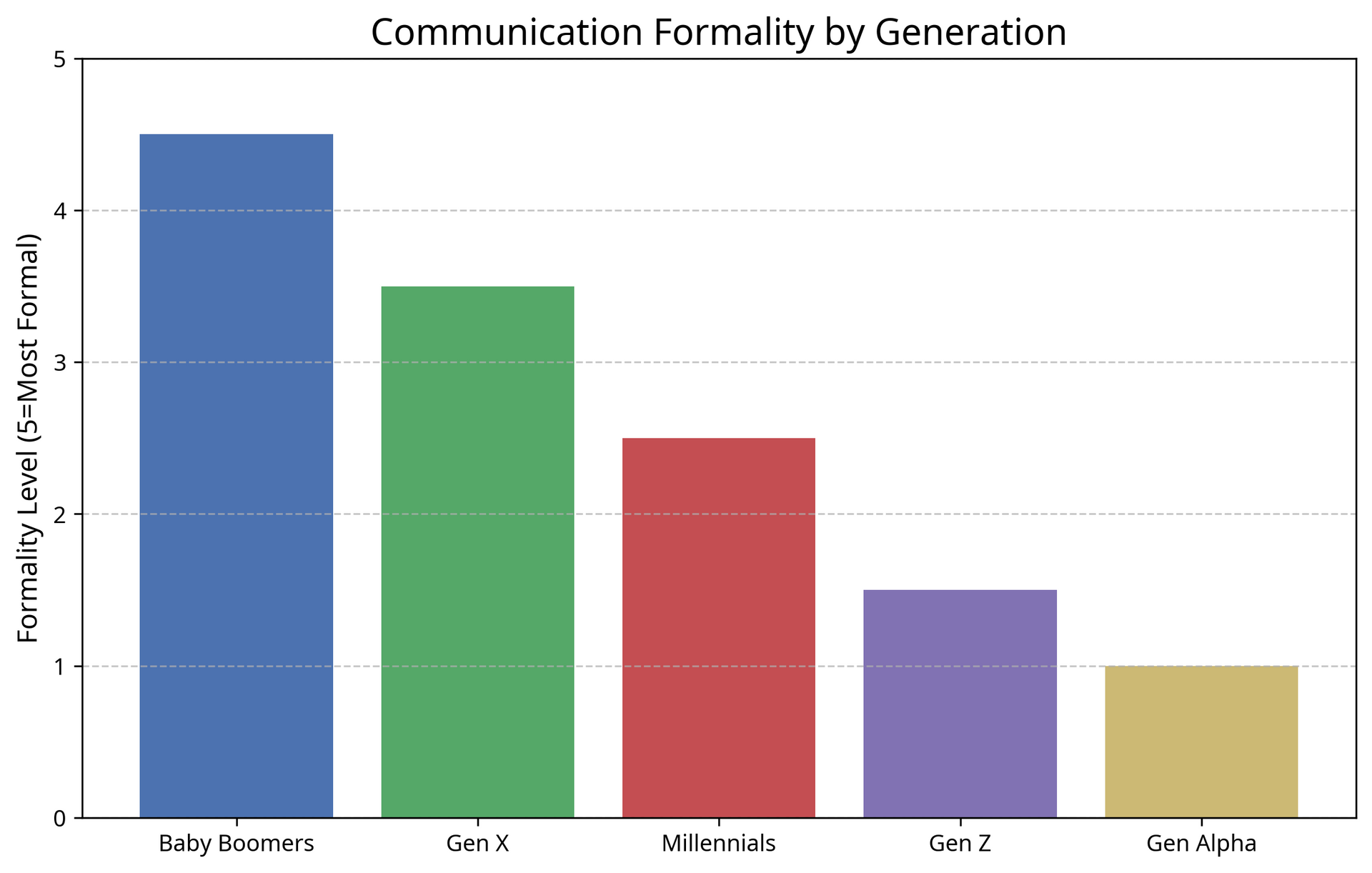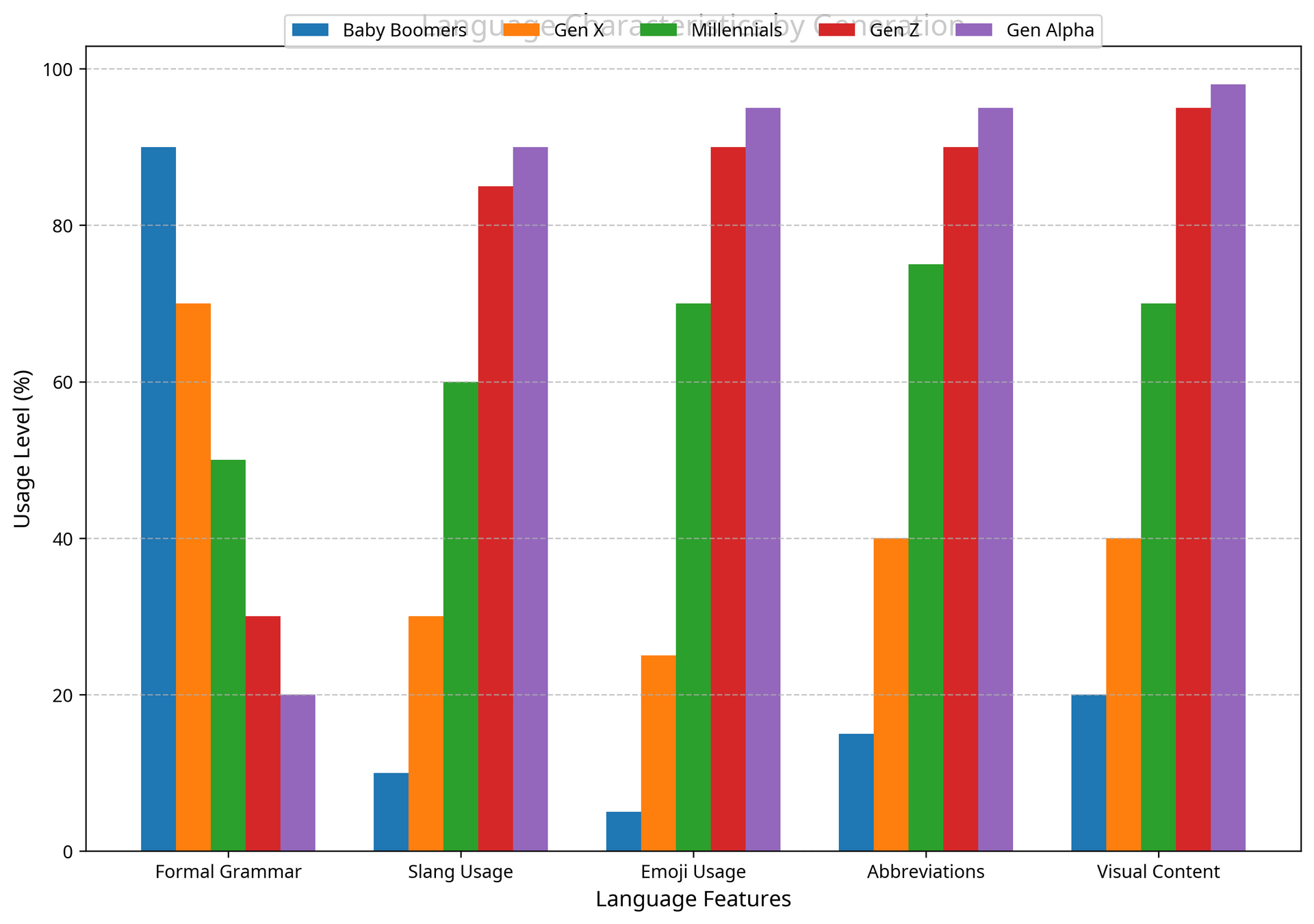Sociolinguistics in Digital Marketing: A Generational Guide

Introduction: Understanding Sociolinguistics in Marketing
Language reveals us. It maps our navigation of the world, our connections, our persuasions. Sociolinguistics watches these patternshow different groups communicate based on age, geography, class, and culture. For marketers, these observations serve as practical tools, not academic curiosities. They help us craft messages that resonate simply by sounding familiar, comfortable, true.
Digital marketing demands an understanding of generational language differences. Each generation came of age in its own cultural moment. Distinct technologies, historical events, and social shifts shaped their vocabularies, rhythms, and references. Words that make Baby Boomers nod might trigger Gen Z eye-rolls. Phrases that prompt Gen Alpha to share might leave Gen X cold and doubtful.
This guide maps the linguistic landscapes of five generations. We offer no formulas or templates—language resists such simplification. We simply chart territories, note patterns, and suggest paths toward speaking in ways that feel authentic to your audience.

Figure 1: Communication Formality Levels Across Generations - Higher values indicate more formal communication preferences.
Baby Boomers (Born 1946-1964): Traditional Communication Values
Sociolinguistic Profile
Baby Boomers grew up when letters came handwritten and long-distance calls cost real money. This created a communication style marked by:
- Formality and structure —complete thoughts in complete sentences
- Attention to detail —they want the full story, not mere highlights
- Selective slang adoption —new terminology enters their vocabulary gradually
- Traditional grammar —they notice broken rules
- Patience with length —they'll read to the end when content matters
Baby Boomers respond to straightforward language that shows respect. They value thoroughness over brevity, substance over style. Clarity outweighs cleverness.
Digital Marketing Applications
When speaking to Baby Boomers:
- Keep some formality : Skip excessive abbreviations and trendy language
- Give context and depth : They want the whole picture
- Highlight enduring value : Quality, reliability, and proven results resonate
- Honor traditional touchstones : Family, stability, and established institutions matter
- Clarify technical concepts : Never assume digital fluency
Example Marketing Copy
Less Effective : "OMG! This app is lit! Download now & save big!"
More Effective : "Discover how our easy-to-use application can help you stay connected with your family while saving you time and money. Click here to learn more about our special offer."
Digital Channel Preferences
- Email marketing with substantive information
- Facebook as their primary social platform
- Traditional websites with comprehensive content
- Video content that informs more than entertains

Figure 2: Digital Channel Preferences Across Generations - Shows how different generations engage with various digital platforms.
Generation X (Born 1965-1980): The Pragmatic Communicators
Sociolinguistic Profile
Generation X straddles analog and digital worlds. Their communication style runs:
- Direct and efficient —less formal than Boomers but rarely casual
- Allergic to polish —they smell marketing language from miles away
- Slang-neutral —they use it but aren't defined by it
- Pragmatic about length —they'll read long copy that earns their time
- Steeped in cultural references —particularly from the 80s and 90s
Gen X prizes honest communication without wasted words. They respond to humor with an edge—irony and sarcasm hit home. They've witnessed enough marketing to recognize when they face it.
Digital Marketing Applications
When speaking to Generation X:
- Stay straightforward : Skip corporate jargon and reach your point
- Make information efficient : Offer substance without demanding time
- Tap shared experiences : Their cultural reference points create connections
- Apply understated humor : Self-awareness trumps enthusiasm
- Respect their skepticism : Address concerns directly, never gloss over them
Example Marketing Copy
Less Effective : "The ultimate revolutionary solution for today's modern lifestyle!"
More Effective : "No hype, no gimmicks. Just a reliable product that saves you time and money. See the results for yourself."
Digital Channel Preferences
- Email marketing that respects their time
- Facebook and LinkedIn for different aspects of life
- Blog content with actual substance
- Mixed media that doesn't require a learning curve
Millennials/Gen Y (Born 1981-1996): Digital Pioneers
Sociolinguistic Profile
Millennials witnessed the social internet's birth. Their language shows this transition:
- Casual by default —formality reads as distant, corporate
- Woven with references —pop culture and internet culture thread through their speech
- Abbreviation-friendly —though less extreme than younger generations
- Emotionally direct —they name feelings instead of implying them
- Socially conscious —word choices reflect values
Millennials demand authenticity. They gravitate toward brands that sound human, not corporate. They expect to be seen as individuals, never demographics.
Digital Marketing Applications
When speaking to Millennials:
- Talk like a person : Minimize distance between brand and individual
- Show your values : Connect your work to meaningful issues
- Mix humor with sincerity : They appreciate both in a single message
- Make it personal : Generic messages read as spam
- Speak to feelings : Emotional connections outweigh feature lists
Example Marketing Copy
Less Effective : "Our product offers superior functionality at competitive market rates."
More Effective : "We created this with you in mind. It's sustainable, affordable, and actually works (we promise). Plus, 5% of profits support environmental conservation."
Digital Channel Preferences
- Instagram and Twitter for different kinds of engagement
- Email marketing that feels personally relevant
- Blog content that tells stories and shares perspectives
- YouTube for learning and entertainment
- Mobile-optimized everything—they're rarely at desktops
Generation Z (Born 1997-2012): Digital Natives
Sociolinguistic Profile
Gen Z never experienced a world without internet. Their communication runs:
- Visual first —emojis and images carry core meaning, not decoration
- Constantly evolving —language shifts quickly, deliberately, playfully
- Brief by nature —paragraphs shrink to phrases by instinct
- Language as clay —words exist to shape, not rules to obey
- Platform-aware —communication style shifts with digital context
Gen Z places authenticity above everything. They detect manufactured "cool" instantly. They respect brands that get their world without awkwardly mimicking their speech.
Digital Marketing Applications
When speaking to Generation Z:
- Think visually : Images often say more than words
- Stay naturally current : Use contemporary language only if authentic
- Reflect diverse voices : Mirror the plurality they expect
- Mix light with meaning : Humor and substance belong together
- Respect platform culture : Each digital space follows distinct linguistic codes
Example Marketing Copy
Less Effective : "Hello, fellow teens! Our product is totally lit and on fleek!"
More Effective : "Real talk: We made this sustainable, affordable, and actually useful. See for yourself. 👀 #NoFilter"
Digital Channel Preferences
- TikTok and Instagram as primary spaces
- YouTube for deeper dives
- Snapchat for ephemeral connection
- Visual communication across all channels
- Interactive content that invites participation
Gen Alpha (Born 2013-Present): The Multimedia Communicators
Sociolinguistic Profile
Born entirely in the 21st century, Gen Alpha communicates through:
- Multimedia synthesis —text, images, audio, and video blend seamlessly
- AI companionship —they've never known life without intelligent assistants
- Borderless influences —geography limits nothing in their world
- Active participation —passive communication feels broken
- Technological fluidity —platform distinctions blur where older generations see clear lines
Gen Alpha weaves digital tools into communication so naturally it startles older generations. They take for granted that experiences will feel personalized, interactive, responsive.
Digital Marketing Applications
When speaking to Generation Alpha:
- Go multi-sensory : Text alone falls flat
- Lead with visuals : Simple symbols can carry complex ideas
- Build interaction : Static content feels obsolete
- Customize everything : Generic material reads as broken
- Show your values : Authenticity comes first, always
Example Marketing Copy
Less Effective : "Our new product has many features that children will enjoy."
More Effective : "Create your own adventure! 🚀 Tap to customize, swipe to explore, share with friends! #YourWorldYourWay"
Digital Channel Preferences
- Short-form video platforms like TikTok
- Interactive gaming environments
- Voice-activated content
- Augmented reality experiences
- AI-enhanced personalized content
Cross-Generational Marketing: Finding Common Ground
The richest conversations cross generational lines. Ways to bridge these gaps:
- Layer your content : Build multiple levels that speak differently to different ages
- Find common ground : Some human experiences transcend generation
- Watch for exclusion : Skip references that might alienate unintentionally
- Listen first : Test your assumptions on real people from varied age groups
- Match platform to message : Digital spaces each carry unique linguistic expectations

Figure 3: Language Characteristics by Generation - Shows how different generations use various language features in their communication.
Best Practices for Sociolinguistic Marketing Across Generations
Across all audiences, these principles hold:
- Watch first : Understanding precedes persuasion
- Question assumptions : Language rarely works how we expect
- Weigh connotations : Words land differently across communities
- Bring in native voices : Include team members from your target audience
- Stay current : Language evolves faster than marketing plans
- Notice distinctions : Sometimes how you say matters more than what you say
- Track what works : Measure which phrasings drive engagement
- Keep flexible consistency : Your voice needs both recognition and adaptation
- Sound human : Strategy should never eclipse authenticity
- See beyond age : Generations contain multitudes—many factors shape speech
Conclusion
Language reveals more than it says. Words expose values, assumptions, worldviews. For marketers, sociolinguistic awareness means connection, not manipulation—finding words that bridge worlds.
Effective generational marketing neither imitates nor panders. It shows genuine understanding and respect for each generation's viewpoint. Language serves not as costume but as bridge.
Digital spaces evolve; language follows. The marketers who thrive listen carefully, adapt thoughtfully, speak authentically—to every generation they address.
References:
- Zhang, S., Schmitt, B. H., & Haley, H. Language and culture: linguistic effects on consumer behavior in international marketing research. Columbia Business School.
- Exploring Language Effects in Ethnic Advertising: A Sociolinguistic Perspective. Journal of Consumer Research.
- Stepaniuk, K., & Jarosz, K. (2021). Persuasive linguistic tricks in social media marketing communication—The memetic approach. PLOS One.
- Theorising the market in sociolinguistics. Cambridge University Press.
- Multinational Brand Names: A Sociolinguistic Perspective. BILD-LIDA (2020).
- A Multifactorial Sociolinguistic Analysis of SME Business Company Names. ScienceDirect.
- Sociolinguistic Effects on Code-Switched Ads Targeting Bilingual Consumers. JSTOR.
- More than Words: Linguistics and Language in Consumer Behavior. Journal of the Association for Consumer Research.
- Cultural Value Adaptation in Advertising is Effective. SAGE Journals (2023).
- Speech Patterns and Persuasion Gaps: Using Sociolinguistics to Audit Sales Conversations. Blue Monarch Group.
- Generational marketing explained: Everything you need to know. TechTarget (2023).
- Talkin' 'Bout The Generations: Gen X Language. Babbel (2021).
- Internet language across generations. Hamline Oracle (2024).
- The Evolution of Slang: From Millennials to Gen Alpha. LinkedIn (2024).
- Gen Alpha Finds Their Own Place in The English Language. The UTC Echo (2024).
- Lost in Translation: Generational Language Differences and the Communication Challenges. Age Diversity Forum (2024).
- Quick Guide to Gen Alpha Slangs: 13 Terms You Must Know. Lingopie (2024).
- How Gen Alpha Transforming the Marketing Landscape. SG Analytics (2025).
- Marketing to Generation Alpha: Everything You Need to Know. Idomoo.
- Understanding Generation Alpha Slang. Babbel (2025).
Start a Conversation
We will get back to you as soon as possible.
Please try again later.





